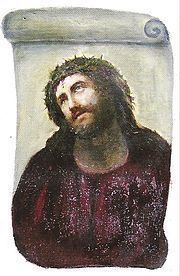Type Fresco Dimensions 50 cm x 40 cm | Artist Elías García Martínez | |
 | ||
Location Sanctuary of Mercy church, Borja Owner Roman Catholic Diocese of Tarazona Similar Mural, Other artwork | ||
The Ecce Homo (Behold the Man) in the Sanctuary of Mercy church in Borja, Spain, is a fresco painted circa 1930 by the Spanish painter Elías García Martínez depicting Jesus crowned with thorns. Both the subject and style are typical of traditional Catholic art.
Contents
- The original mural
- Failed restoration attempt and Internet phenomenon
- Artistic significance
- Tourist success
- References
While press accounts agree that the original painting was artistically unremarkable, its fame derives from a good faith attempt to 'restore' the fresco by Cecilia Giménez, an untrained elderly amateur, in 2012. The intervention reinterpreted the painting and made it look similar to a monkey, and for this reason it is sometimes known as Ecce Mono (Behold the Monkey).
The original mural
The artist, a professor at the School of Art of Zaragoza, gave the painting to the village where he used to spend his holidays, painting it directly on the wall of the church about 1930. He commented that "this is the result of two hours of devotion to the Virgin of Mercy". His descendants still reside in Zaragoza and were aware that the painting had deteriorated seriously; his grand-daughter had made a donation toward its restoration shortly before they discovered that the work had been radically altered in an incomplete attempt to restore it.
Failed restoration attempt and Internet phenomenon
The authorities in Borja said they had suspected vandalism at first, but then determined that the alterations had been made by an elderly parishioner, Doña Cecilia Giménez, who was in her 80s. She said on Spanish national television that she had started to restore the fresco, because she was upset that parts of it had flaked off due to moisture on the church's walls. Giménez defended herself, saying she could not understand the uproar because she had worked in broad daylight and had tried to salvage the fresco with the approval of the local clergyman. "The priest knew it," she told Spanish television. "I've never tried to do anything hidden."
News of the disfigured painting spread around the globe in August 2012 on mainstream and social media, which promptly led to the status of an internet phenomenon. BBC Europe correspondent Christian Fraser said that the result resembled a "crayon sketch of a very hairy monkey in an ill-fitting tunic". The restored version has been jokingly dubbed "Ecce Mono" ('Behold the Monkey,' ecce is Latin, whereas mono is Spanish for 'monkey'; in Latin, it is simius) in an "online rush of global hilarity", and compared to the plot of the film Bean. Because of the negative attention, the priest of the church, Father Florencio Garces, thought the painting should be covered up.
Artistic significance
Tongue-in-cheek critiques have interpreted the piece as a multifaceted comment on both sacred and secular themes. A Forbes commentator suggested that the "inept restoration" represented "one woman's vision of her savior, uncompromised by schooling." In September 2012 the artistic group Wallpeople presented hundreds of reworked versions of the new image on a wall near the Centre de Cultura Contemporània de Barcelona. An organizer commented that "Cecilia has created a pop icon".
Tourist success
The interest from tourists was such that the church began charging to see the fresco. In the year following the failed restoration, tourist activity generated 40,000 visits and more than €50,000 for a local charity. Giménez has sought a share of the royalties. Giménez's lawyer said that she wanted her share of the profits to help muscular dystrophy charities, because her son suffers from the condition. By 2016, tourist numbers to the town had increased from 6,000 to 57,000; in addition to spending money with local businesses, visitors have donated some €50,000 to the church. The money has been used to employ additional attendants at the church and to fund an old people's home. On 16 March 2016, an interpretation centre dedicated to the artwork was opened in Borja.
